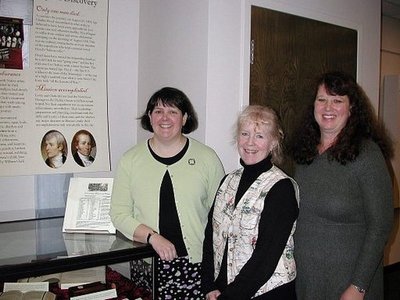December 1, 2005
Exhibit shows medical world of Lewis & Clark
11th February Monday 1805.
“About five o’clock this evening one of the wives of Charbono was delivered of a fine boy. It is worthy of remark that this was the first child which this woman had born and as is common in such cases her labor was tedious and the pain violent; Mr. Jessome informed me that he had frequently administered a small portion of the rattle of the rattle-snake, which he assured me had never failed to produce the desired effect, that of hastening the birth of the child; having the rattle of a snake by me I gave it to him and he administered two rings of it to the woman broken in small pieces with the fingers and added to a small quantity of water. Whether this medicine was truly the cause or not I shall not undertake to determine, but I was informed that she had not taken it more than ten minutes before she brought forth. Perhaps this remedy may be worthy of future experiments, but I must confess that I want faith as to its efficacy.”
This account in Meriwether Lewis’ journal of the birth of Sacagawea’s son depicts the “medicine” practiced during the expedition led by Lewis and William Clark from 1804 to 1806.
Or Perish in the Attempt … Medical Adventures of Lewis and Clark and the Corps of Discovery, now on exhibit at the Health Sciences Library, details the varied treatments and interventions available 200 years ago as the expedition made its way from St. Louis to the Pacific and back.
The exhibit comprises the poster and handout created by Lisa Oberg, head of outreach services for the Health Sciences Library, and Gail Kouame, consumer health coordinator for the National Network of Libraries of Medicine/Pacific Northwest Region. The exhibit case display was created by Colleen Weum, acquisitions and collections management librarian for the Health Sciences Library.
Lewis prepared for the expedition by taking a two-week “crash course” in medicine with the pre-eminent physician of the day, Dr. Benjamin Rush. Jefferson chose not to send a physician along on the journey.
“But Rush’s main cure was a pill called a ‘thunderclapper,’ which contained calomel and jalap,” Oberg said. A bottle of Dr. Rush’s pills is on display in the case.
Like many medicines of the day, Rush’s pills were termed a purgative, a laxative believed to cleanse the person of whatever was ailing them. Lewis and Clark took along 50 dozen pills for the Corps.
The medical items purchased for the Lewis and Clark expedition totaled just $90.69. A third was spent on 15 pounds of Peruvian bark, which contained quinine, used for treating fevers and malaria.
The medicine chest also included mercury, a popular treatment for syphilis and other venereal diseases; opium and laudanum, used as a painkiller and sedative; medical and dental instruments, and lancets for blood-letting, another popular treatment of the day. Examples of a medicine chest from that era, along with a blood letting tool, are also displayed in the case.
“It’s phenomenal that more people didn’t die from the therapy they received,” said Kouame. “They were more fond of the purgatives than the blood-letting route. But they survived in spite of the interventions.”
The only death among the 31 members of the Corps was Sergeant Floyd, who succumbed to what was probably appendicitis early in the trip west.
“All the men were in the Army,” Oberg said. “They probably survived as much as anything else because they were strong, seasoned soldiers.”
The expedition battled harsh weather conditions, including a miserable rainy winter at Fort Clatsop after reaching the Pacific Ocean in November 1805.
There were many broken bones and other illnesses like dysentery. At one point Lewis boiled chokecherry twigs into a concoction to treat his own severe abdominal pain.
There were non-human threats as well.
“Several members of the party were treed by grizzly bears,” said Kouame, “and Seaman, the dog that accompanied them, was bitten by a beaver and also suffered porcupine quills in his nose.”
Later in the expedition, the situation grew more desperate for the men and they traded medical treatments with the natives for food and goods.
This is the first exhibit the Health Sciences Library has created in its new display case. It includes rare books from the library collection, which feature medicinal plants and therapies used by Lewis and Clark. Historical medical instruments and Dr. Rush’s pills are courtesy of the Department of Medical History and Ethics and Dr. James Whorton.
The exhibit will be on display through February at the Health Sciences Library. Enter on the third floor of the T-Wing (T-334) of the Health Sciences Center and look to the left.



